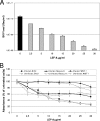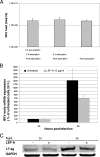Leflunomide inhibition of BK virus replication in renal tubular epithelial cells
- PMID: 19955306
- PMCID: PMC2812362
- DOI: 10.1128/JVI.01737-09
Leflunomide inhibition of BK virus replication in renal tubular epithelial cells
Abstract
The immunomodulatory drug leflunomide is frequently used for treating polyomavirus-associated nephropathy, yet its antiviral mechanism is unclear. We characterized the effects of the active leflunomide metabolite A771726 (LEF-A) on the polyomavirus BK (BKV) life cycle in human renal tubular epithelial cells. LEF-A at 10 microg/ml reduced the extracellular BKV load by 90% (IC(90)) but with significant host cytostatic effects. BKV genome replication, late protein expression, and virion assembly and release were inhibited with visible disruption of the nuclear replication architecture. Both host cell and antiviral effects were largely reversed by uridine addition, implicating nonspecific pyrimidine depletion as the major anti-BKV mechanism of leflunomide.
Figures





Similar articles
-
Fluoroquinolones inhibit human polyomavirus BK (BKV) replication in primary human kidney cells.Antiviral Res. 2011 Oct;92(1):115-23. doi: 10.1016/j.antiviral.2011.07.012. Epub 2011 Jul 21. Antiviral Res. 2011. PMID: 21798289
-
Effect of Leflunomide, Cidofovir and Ciprofloxacin on replication of BKPyV in a salivary gland in vitro culture system.Antiviral Res. 2015 Jun;118:46-55. doi: 10.1016/j.antiviral.2015.02.002. Epub 2015 Mar 16. Antiviral Res. 2015. PMID: 25790744 Free PMC article.
-
Effect of leflunomide and cidofovir on replication of BK virus in an in vitro culture system.Transplantation. 2005 Jan 15;79(1):116-8. doi: 10.1097/01.tp.0000149338.97084.5f. Transplantation. 2005. PMID: 15714178
-
Antivirals for the treatment of polyomavirus BK replication.Expert Rev Anti Infect Ther. 2007 Feb;5(1):105-15. doi: 10.1586/14787210.5.1.105. Expert Rev Anti Infect Ther. 2007. PMID: 17266458 Review.
-
Clinical Pharmacokinetic Monitoring of Leflunomide in Renal Transplant Recipients with BK Virus Reactivation: A Review of the Literature.Clin Pharmacokinet. 2017 Sep;56(9):1015-1031. doi: 10.1007/s40262-017-0521-9. Clin Pharmacokinet. 2017. PMID: 28247238 Review.
Cited by
-
Reining in polyoma virus associated nephropathy: design and characterization of a template mimicking BK viral coat protein cellular binding.Biochemistry. 2012 Oct 16;51(41):8092-9. doi: 10.1021/bi300639d. Epub 2012 Oct 2. Biochemistry. 2012. PMID: 23002929 Free PMC article.
-
BK polyomavirus: emerging pathogen.Microbes Infect. 2012 Aug;14(9):672-83. doi: 10.1016/j.micinf.2012.02.002. Epub 2012 Feb 24. Microbes Infect. 2012. PMID: 22402031 Free PMC article. Review.
-
Potential Anti-SARS-CoV-2 Therapeutics That Target the Post-Entry Stages of the Viral Life Cycle: A Comprehensive Review.Viruses. 2020 Sep 26;12(10):1092. doi: 10.3390/v12101092. Viruses. 2020. PMID: 32993173 Free PMC article. Review.
-
Use of Leflunomide as an Antiviral Agent with Everolimus for BK Virus Nephropathy Patients After Kidney Transplantation: A Case Series.Am J Case Rep. 2020 Nov 25;21:e927367. doi: 10.12659/AJCR.927367. Am J Case Rep. 2020. PMID: 33235184 Free PMC article.
-
Human polyomavirus reactivation: disease pathogenesis and treatment approaches.Clin Dev Immunol. 2013;2013:373579. doi: 10.1155/2013/373579. Epub 2013 May 2. Clin Dev Immunol. 2013. PMID: 23737811 Free PMC article. Review.
References
-
- Awdishu, L., E. Sonbol, A. Feist, F. Lin, O. Alemi, R. Huang, and R. Pharmacy. 2009. Leflunomide delays recovery in kidney transplant recipients with BK viremia. American Transplant Congress 2009, abstr. L 503.
-
- Bansal, S., M. S. Lucia, and A. Wiseman. 2008. A case of polyomavirus-associated nephropathy presenting late after transplantation. Nat. Clin. Pract. Nephrol. 4:283-287. - PubMed
-
- Basse, G., C. Mengelle, N. Kamar, J. Guitard, D. Ribes, L. Esposito, and L. Rostaing. 2007. Prospective evaluation of BK virus DNAemia in renal transplant patients and their transplant outcome. Transplant. Proc. 39:84-87. - PubMed
-
- Baumann, P., S. Mandl-Weber, A. Volkl, C. Adam, I. Bumeder, F. Oduncu, and R. Schmidmaier. 2009. Dihydroorotate dehydrogenase inhibitor A771726 (leflunomide) induces apoptosis and diminishes proliferation of multiple myeloma cells. Mol. Cancer Ther. 8:366-375. - PubMed
-
- Bernhoff, E., T. J. Gutteberg, K. Sandvik, H. H. Hirsch, and C. H. Rinaldo. 2008. Cidofovir inhibits polyomavirus BK replication in human renal tubular cells downstream of viral early gene expression. Am. J. Transplant. 8:1413-1422. - PubMed
Publication types
MeSH terms
Substances
LinkOut - more resources
Full Text Sources
Molecular Biology Databases

